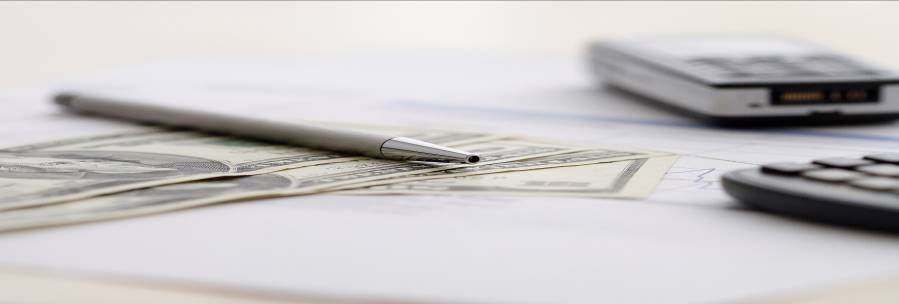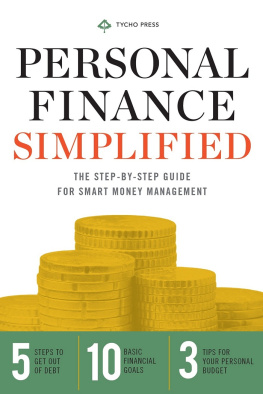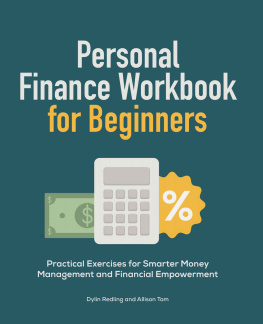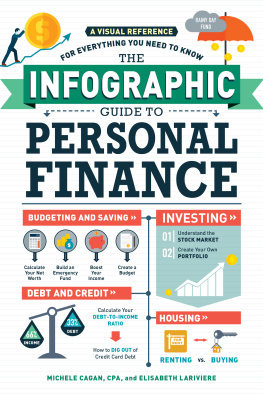Personal Finance Your Way
S. M. Green
Copyright 2014 S. M.Green
Published by S. M. Green
Smashwords Edition LicenseNotes
This book is licensed for your personalenjoyment only. This book may not be re-sold or given away to otherpeople. If you would like to share this book with another person,please purchase an additional copy for each recipient. If yourereading this book and did not purchase it, or it was not purchasedfor your enjoyment only, then please return to Smashwords.com oryour favorite retailer and purchase your own copy. Thank you forrespecting the hard work of this author.
DEDICATION
This book is dedicated to those who have adesire to take control of your personal finance. Although there aremany agencies and resources that offer assistance in managing yourcredit card payments as well as assistance during times of crisis,my goal is to empower you to assess, manage, and control yourfinance, not from a template but, based on your household incomeand resources your way
CONTENTS
Legal disclaimer andacknowledgements
This book is provided as an informationalresource only and to provide an overview of personal finances. Allreferences included are provided as the most current informationavailable at the time of this writing. Understanding how things areever changing, please be aware that some content may have changedor been deleted since originally published.
I do not receive any compensation from any ofthe services or resources mentioned in this book but instead amcommitted to sharing interesting and entertaining information thatI have personally taken advantage of or have received positivefeedback from others.
The author/publisher specifically disclaimliability, loss, or risk that is incurred as an outcome, directlyor indirectly, through the use and application of any contents ofthe work.
End User Rights
No part of this book may be reproduced ortransmitted in any form or by any means, electronic ormechanically, including photocopying, recording, or by anyinformation storage and retrieval system without prior writtenpermission from the publisher.
Start from the Beginning AssessYour Financial Health
W hen you or a familymember are feeling ill, you dont hesitate to make an appointmentto the doctors office. Once you arrive, they ask you variousquestions, sometimes draw blood, or may even need to order x-raysor tests, depending on your illness, before they can begin treatingyou. In the same manner, from time to time we need to assess ourfinancial health to gauge if a treatment plan is needed to get itback into prime condition.
 Faced with the challenges of an unsteady economy,high unemployment, increasing layoffs, a rise in student loan debt,credit card debt, and an unstable stock market, more and moreconsumers must re-evaluate their personal finances and make changesto avoid default, repossessions, foreclosures, and/or bankruptcy.Just as many of us are diligent in managing our physical healththrough annual doctor visits, we should also assess our financialhealth on a continuous basis to adjust for unexpected and unplannedlife changes.
Faced with the challenges of an unsteady economy,high unemployment, increasing layoffs, a rise in student loan debt,credit card debt, and an unstable stock market, more and moreconsumers must re-evaluate their personal finances and make changesto avoid default, repossessions, foreclosures, and/or bankruptcy.Just as many of us are diligent in managing our physical healththrough annual doctor visits, we should also assess our financialhealth on a continuous basis to adjust for unexpected and unplannedlife changes.
The following are four simple steps to helpyou obtain an overall picture of your monthly income and expenses.Once done, you will be better prepared to move forward in planningand executing an effective personal financial plan.
Step One: Gather ALLof Your Bills. Pull together copies of everything that you owe frommortgage payments to outstanding doctors bills. With more and morecompanies going paperless, remember to print off any onlinestatements that you receive, including your most recent bankstatement. Separate these bills, both paper and electronic, intotwo stacks - one for monthly household expenses and one forcredit cards, installments, and loans. Use the bank statement todocument you monthly expenses for food and other incidentals. Dontforget to account for monthly fees, regardless of how small, thatyou are charged such as bank fees. Incredibly these fees can add upand throw off your budget completely.
Step Two: DocumentHousehold Expenses and Debts. Having a clear picture of yourmonthly income and expenses allows you to be better suited toidentify areas where reductions may be necessary as well as seeing,at a glance, if your monthly income is sufficient to maintaincurrent expenses. Microsoft Office has a variety of templatesavailable to track expenditures that can be downloaded or printed.If you are familiar with Excel, download the Excel template as itcontains formulas already implanted that will calculate as youenter the information. Save the Excel document on your computer orlaptop and enter income and expenses under the appropriatecategory. Resources of this sort are available online for free frombasic to elaborate worksheets. I encourage you to find the best oneto captures your types of expenses and save it for future use..
Step Three : DocumentExpenses that are paid Semi-Annually or Annually. There are severalexpenses that are only paid annually or semi-annually such as autoregistration, inspections, property taxes, and even some insurance.These expenses are considered variable fixed expenses. To determinethe monthly expense of these items, multiple the total by 12(annually) or 6 (semi-annually) and enter the total for thatexpense. (Example: Auto registration is $102 annually 102 dividedby 12 is $8.50 (monthly expense). Again, remember that even thoughthe expense may seem small, if not included you will not obtain atruly accurate representation of your financial picture.
Step Four: DocumentAll Monthly Income Received. After entering all of your expenses,you will now look at your monthly income and resources. Documentyour total take-home pay from all sources including wages, alimony,child support, and any others. If you receive rent from others,include it. If you have a home based business, enter the averagemonthly income you receive, if any. Even if you receive a monthlyallowance or stipend from someone else, it should be included.
EXCEPTION: Anymonthly income currently being received that is expected to endwithin the next six months does not have to be included unless youplan to revise your budget once that income source has ended.
Youre Done!
After completing these simple steps youshould be able to determine, at a glance, if you are bringing inenough money to cover your expenses, where your money is going andwhere changes can be made to help you get into a better financialposition.
Know Your Debt to IncomeRatio
Imagine the following scenario:
Sara Jones is a single, employed woman witha gross (before taxes) monthly income of $4,000. She pays her rentof $1,000 on time every month. Sara has several credit cards withpayments totaling $350, but they are not delinquent because shemakes sure to send in the payment due each month, even if somepayments are a little late. She also has a student loan payment of$100 each month. Saras car payment each month is $400. Saradecides that she would like to begin looking for a home and appliesfor a loan through her bank but is turned down for the loan. Shewonders, How can I be turned down when I pay my bills eachmonth?
I n all likelihood,after pulling Saras credit report and looking at thedebt-to-income ratio, the bank surmised that Sara posed a highcredit risk and would be less likely to repay the loan. Manyfinancial institutions agree that your debt to income ratio shouldnot exceed 36% of your gross monthly income. In the scenario above,the total monthly debt is $1850. To establish your debt-to-incomeratio, divide your monthly debt payment by your monthly income. Theend result is your debt-to-income ratio.
Next page










 Faced with the challenges of an unsteady economy,high unemployment, increasing layoffs, a rise in student loan debt,credit card debt, and an unstable stock market, more and moreconsumers must re-evaluate their personal finances and make changesto avoid default, repossessions, foreclosures, and/or bankruptcy.Just as many of us are diligent in managing our physical healththrough annual doctor visits, we should also assess our financialhealth on a continuous basis to adjust for unexpected and unplannedlife changes.
Faced with the challenges of an unsteady economy,high unemployment, increasing layoffs, a rise in student loan debt,credit card debt, and an unstable stock market, more and moreconsumers must re-evaluate their personal finances and make changesto avoid default, repossessions, foreclosures, and/or bankruptcy.Just as many of us are diligent in managing our physical healththrough annual doctor visits, we should also assess our financialhealth on a continuous basis to adjust for unexpected and unplannedlife changes.